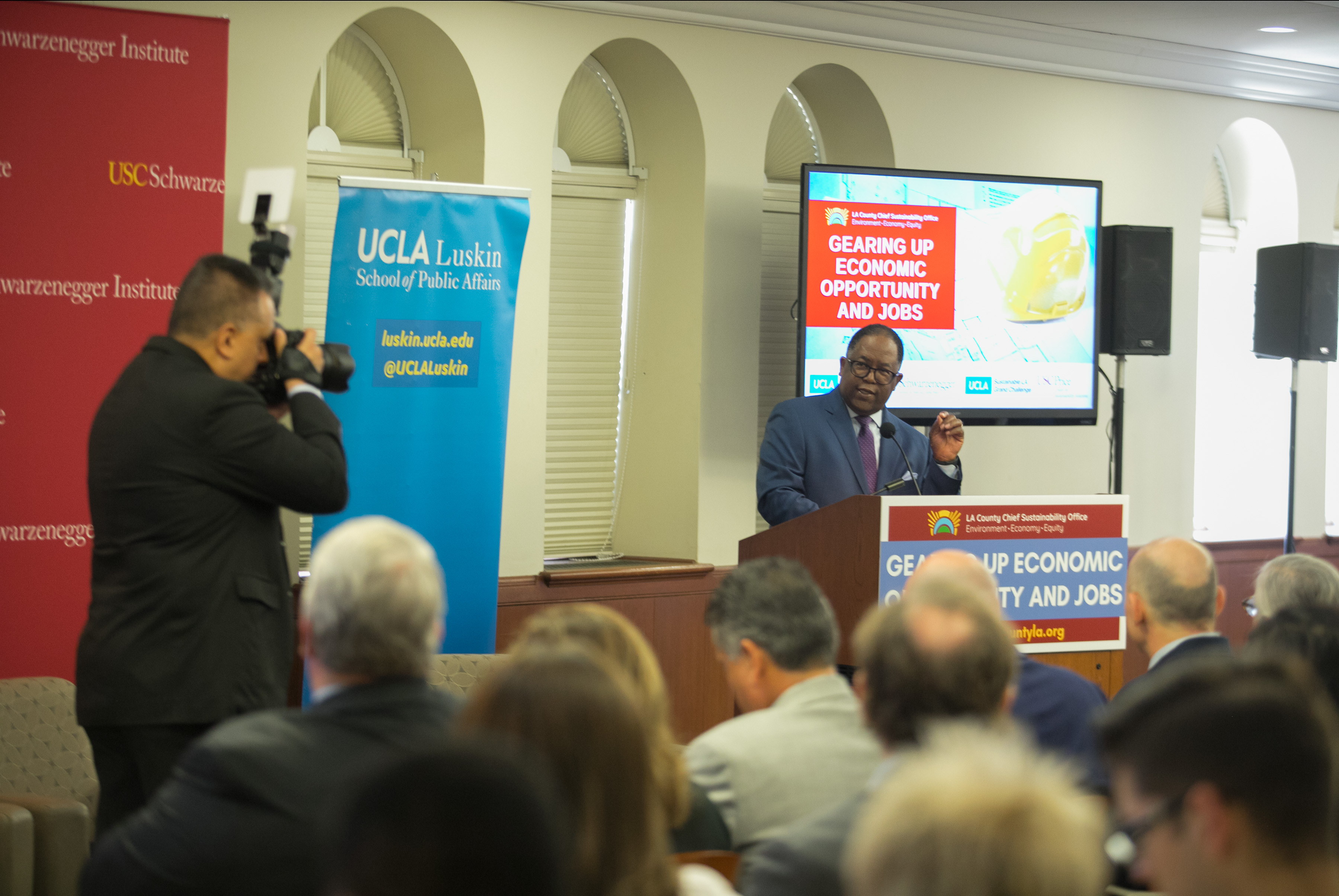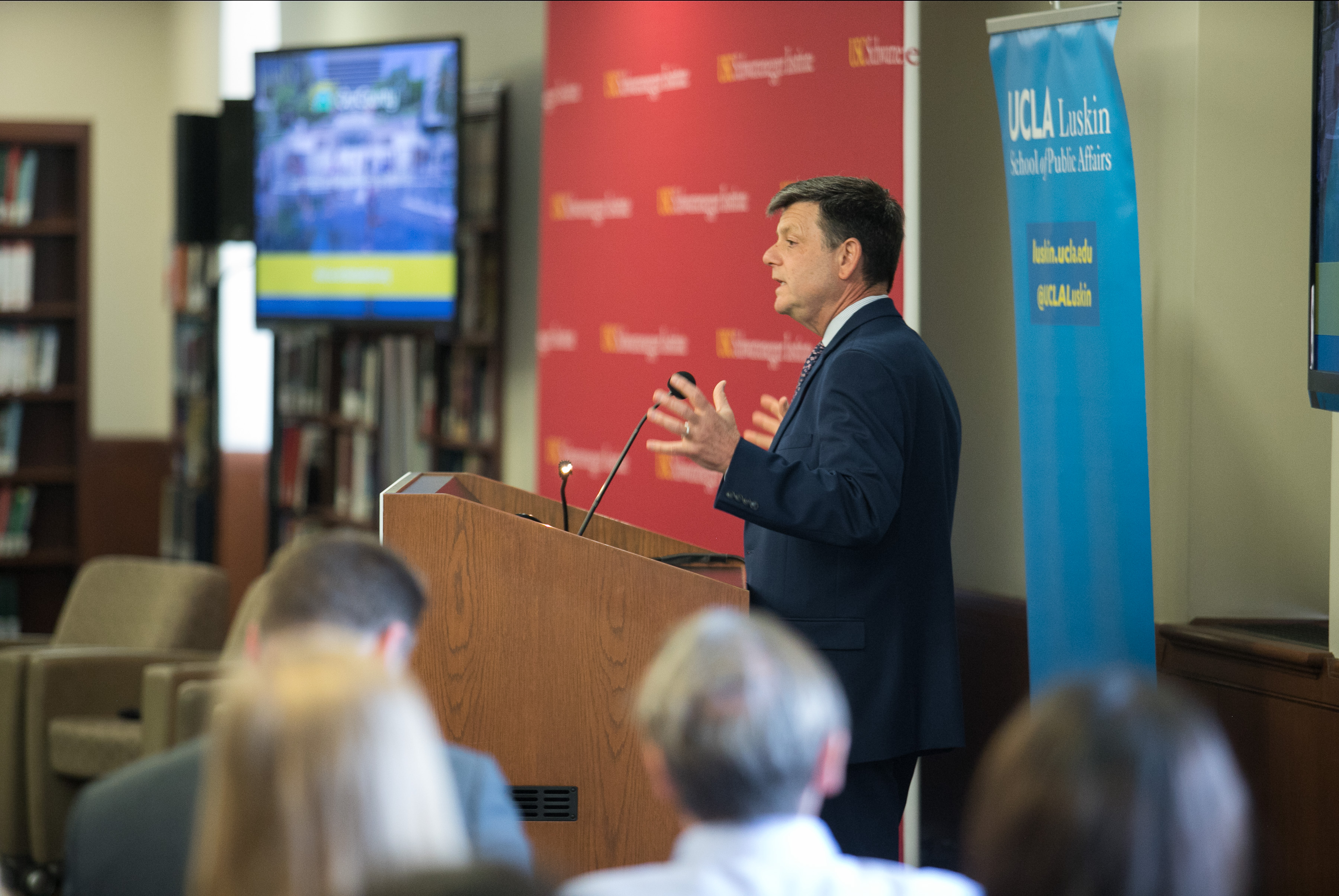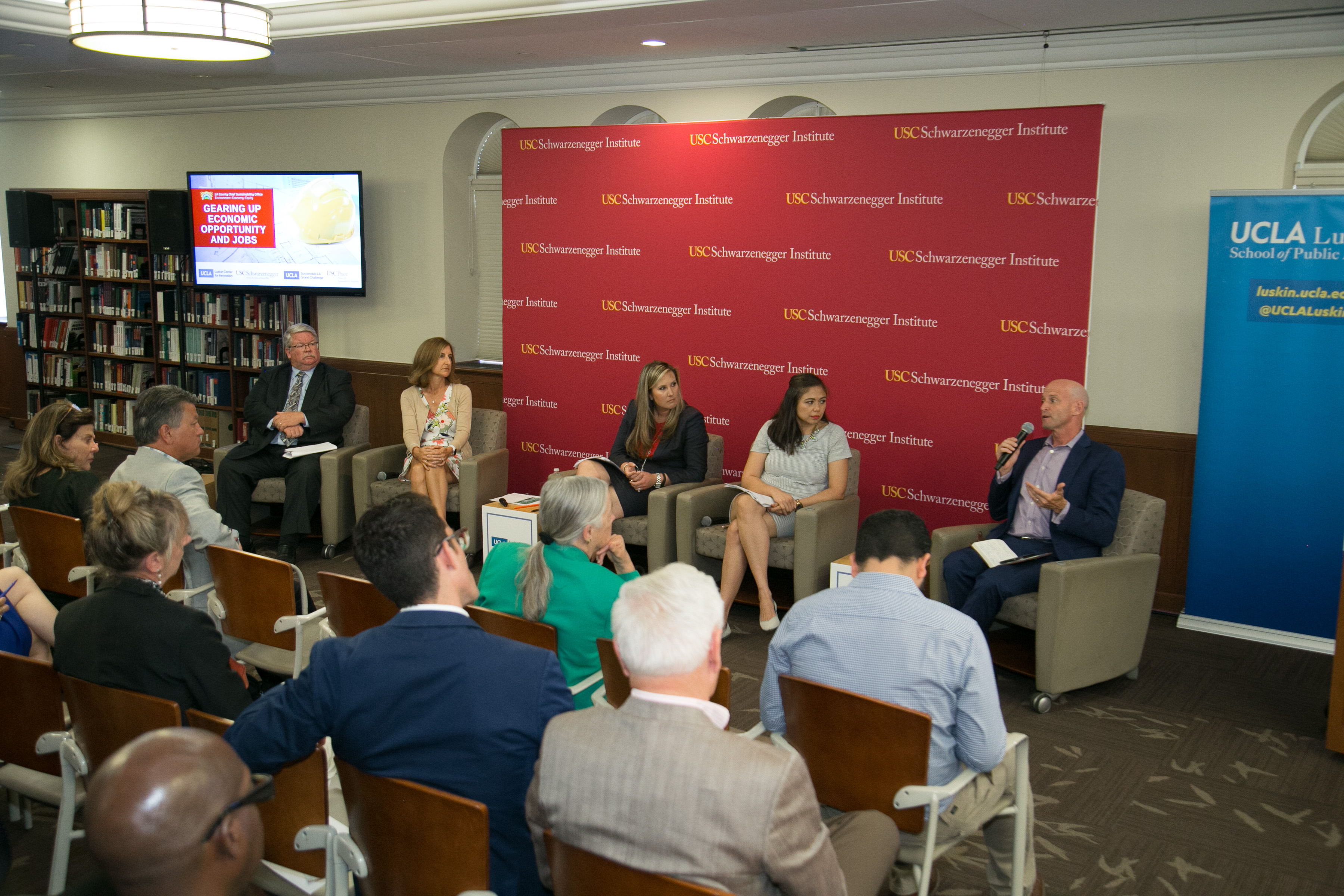Making Los Angeles into a worldwide model of sustainability is going to take leaders from all sectors working together, even at its crosstown-rival universities.
The USC Schwarzenegger Institute for State and Global Policy joined with the UCLA Luskin Center for Innovation to host a preview and discussion of the Los Angeles County Sustainability Plan on July 17 at USC’s Doheny Memorial Library.
“I’m very impressed that USC and UCLA have put aside their crosstown rivalry to host this terrific event,” said USC Vice Provost Mark Todd. “I think for important issues like this, we should agree to work together and put our collective brainpower towards them, and relegate our rivalries to much less important things like football.”
Former California Gov. Arnold Schwarzenegger, who has made sustainability and a green future key focuses of his institute at the USC Price School of Public Policy, was unable to attend the event because he was participating in a Comic Con press conference for his new film Terminator: Dark Fate. However, he interrupted an interview with a French newspaper to welcome the audience over FaceTime video.
“We have to solve the problems not only for Los Angeles County but because we can be the model for other cities and other counties around this country and the world,” Schwarzenegger said. “People can copy what we’re doing here and the great leadership we are showing. I just want to say thank you to everyone. Sorry that I cannot be there myself, but I’ll be back.”
Preparation of the first ever LA County Sustainability Plan began in late 2017. On August 6th, LAC Chief Sustainability Officer Gary Gero plans to present the finished product to the Board of Supervisors.
Gero explained that the Plan is an effort to outline an inclusive vision for growth that balances the values of environment, equity and economy. Countywide in scope, it will set regional goals, targets and strategies that support healthy communities, environmental stewardship and a just economy.
“Our vision was that this would be the boldest, most ambitious sustainability plan anywhere in the United States, and I think we achieved that vision with what we put out in April,” Gero said.
Following 150 meetings and 11 workshops with stakeholders from business, labor, academia, community members and environmental organizations, the Chief Sustainability Office whittled down 6,000 ideas to 150 specific actions by April. Following a public comment period, the office refined and revised the Plan for the big unveiling.
The Plan will present a comprehensive pathway to sustainability addressing a wide range of subjects including climate change, water, energy, resource management, land use, transportation, open space, biodiversity, public health, economy and workforce development, housing, resilience, and governance.
Gero attested that the Sustainability Office is focused on the importance of equity, and there’s a lot in the Plan to address historic inequities.
“We understand that Los Angeles in particular has communities that have been discriminated against and disproportionately impacted by pollution,” Gero said.
Gero added that the Plan calls for some very ambitious targets: carbon neutrality by 2050, 100% renewable energy by 2025, increasing water obtained locally to 80%, promoting electric vehicles and zero-emission transportation.
“We have the ability through the Sustainability Plan to provide Los Angeles with good, quality clean jobs that are safer and healthier for our communities, and we have the opportunity to provide entrepreneurs with new areas for investment to continue to grow our economy for the long term in a sustainable way,” Gero said in conclusion.
LAC Supervisor Mark Ridley-Thomas asserted that the Board is already prepared to help implement the plan.
“We’re ready to get to work,” Ridley-Thomas said. “I’m confident that the county is poised to use its procurement power – and there’s a lot of power attached to the procurement capacity in the county – its land-use authority, and its economic and workforce development incentives, to support the growth of a cleaner economy and a stronger and more vibrant region.”
He called on everyone in the room to make sure that the county is following through on the plan’s recommendations.
“I ask you to hold us accountable to this, to stay engaged as we seek to harness our collective intellect and resolve to not just talk about these things but to be about these things, to do these things, and future generations will be better for it,” Ridley-Thomas said.
Ridley-Thomas credited former California State Senator Fran Pavley with igniting the effort for a green future in California.
Now environmental policy director for the USC Schwarzenegger Institute, Pavley moderated a panel discussion on supporting business growth for a green economy that featured Sam Jammal, senior manager of government relations for BYD; Bob Keefe, executive director of Environmental Entrepreneurs; Mia Lehrer, president of Studio-MLA; and Mary Leslie, president of the Los Angeles Business Council .
“Let’s have today’s panel of experts discuss the Los Angeles County Sustainability Plan as a vehicle to create and accelerate the demand for issues such as advanced transportation, renewable energy, waste management, energy efficiency, urban greening and workforce development,” Pavley said. “LA County, not just Silicon Valley, has the opportunity to become the new leader in this environment. What is the best way to integrate climate resilience and economic development? There is evidence that businesses are choosing sustainability cities.”
Leslie credited Gero and his team for a Herculean effort, but warned that there remains a lot of work to bring this plan to fruition.
“As my former employer Mayor Riordan would say, ‘OK you’re 5% there now,’” Leslie said. “Now the hard work of the 95% implementation begins in earnest, and that’s the truth. Because I think a lot of what we’ve seen either works or doesn’t work is in the implementation. You’ve got to get it right on the ground and put a lot of disparate pieces together to do it.”
Jammal emphasized the opportunity that the region faces in creating jobs in new spaces.
“When we look at the jobs challenge, when we look at income inequality – because the government’s all in and the investments are there – this really is a space where we can help bridge some of that gap and create some of the equality of opportunity,” Jammal said. “I think that is where a lot of the excitement comes in. If we can start doing some of these big things, we can actually start to create some of these good jobs.”
There will be an opportunity to train Angelenos to take those jobs. The second panel, moderated by J.R. DeShazo, director of the UCLA Luskin Center, focused on workforce development benefits from the Sustainability Plan.
The panel featured Wendy Butts, CEO of Los Angeles Conservation Corps; Ron Miller, executive secretary of Los Angeles/Orange Counties Building & Construction Trades Concil; Estelle Reyes, senior vice president of Los Angeles Cleantech Incubator; and Caroline Torosis, director of economic and business development at Los Angeles County Workforce Development Department.
Torosis contended that there is still a gap in skilled work-ready individuals for jobs in the green economy. She called for more registered apprenticeships and credential programs, as well as an effort to convince employers that they can get workers just as skilled from these areas as someone who has a bachelor’s degree.
Miller reminded people that nearly 50% of the County’s workforce is at retirement age, and the panelists agreed that this created an opportunity for industries to shift – out with the gray and in with the green.





